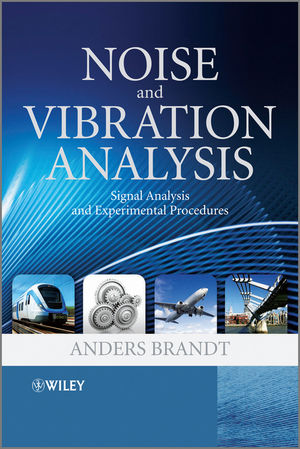Noise and Vibration Analysis: Signal Analysis and Experimental ProceduresISBN: 978-0-470-74644-8
Hardcover
464 pages
February 2011
 This is a Print-on-Demand title. It will be printed specifically to fill your order. Please allow an additional 10-15 days delivery time. The book is not returnable.
|
||||||
Preface.
Acknowledgements.
List of Abbreviations.
Notation.
1 Introduction.
1.1 Noise and Vibration.
1.2 Noise and Vibration Analysis.
1.3 Application Areas.
1.4 Analysis of Noise and Vibrations.
1.5 Standards.
1.6 Becoming a Noise and Vibration Analysis Expert.
2 Dynamic Signals and Systems.
2.1 Introduction.
2.2 Periodic Signals.
2.3 Random Signals.
2.4 Transient Signals.
2.5 RMS Value and Power.
2.6 Linear Systems.
2.7 The Continuous Fourier Transform.
2.8 Chapter Summary.
2.9 Problems.
References.
3 Time Data Analysis.
3.1 Introduction to Discrete Signals.
3.2 The Sampling Theorem.
3.3 Filters.
3.4 Time Series Analysis.
3.5 Chapter Summary.
3.6 Problems.
References.
4 Statistics and Random Processes.
4.1 Introduction to the Use of Statistics.
4.2 Random Theory.
4.3 Statistical Methods.
4.4 Quality Assessment of Measured Signals.
4.5 Chapter Summary.
4.6 Problems.
References.
5 Fundamental Mechanics.
5.1 Newton’s Laws.
5.2 The Single Degree-of-freedom System (SDOF).
5.3 Alternative Quantities for Describing Motion.
5.4 Frequency Response Plot Formats.
5.5 Determining Natural Frequency and Damping.
5.6 Rotating Mass.
5.7 Some Comments on Damping.
5.8 Models Based on SDOF Approximations.
5.9 The Two-degree-of-freedom System (2DOF).
5.10 The Tuned Damper.
5.11 Chapter Summary.
5.12 Problems.
References.
6 Modal Analysis Theory.
6.1 Waves on a String.
6.2 Matrix Formulations.
6.3 Eigenvalues and Eigenvectors.
6.4 Frequency Response of MDOF Systems.
6.5 Time Domain Simulation of Forced Response.
6.6 Chapter Summary.
6.7 Problems.
References.
7 Transducers for Noise and Vibration Analysis.
7.1 The Piezoelectric Effect.
7.2 The Charge Amplifier.
7.3 Transducers with Built-In Impedance Converters, ‘IEPE’.
7.4 The Piezoelectric Accelerometer.
7.5 The Piezoelectric Force Transducer.
7.6 The Impedance Head.
7.7 The Impulse Hammer.
7.8 Accelerometer Calibration.
7.9 Measurement Microphones.
7.10 Microphone Calibration.
7.11 Shakers for Structure Excitation.
7.12 Some Comments on Measurement Procedures.
7.13 Problems.
References.
8 Frequency Analysis Theory.
8.1 Periodic Signals – The Fourier Series.
8.2 Spectra of Periodic Signals.
8.3 Random Processes.
8.4 Transient Signals.
8.5 Interpretation of spectra.
8.6 Chapter Summary.
8.7 Problems.
References.
9 Experimental Frequency Analysis.
9.1 Frequency Analysis Principles.
9.2 Octave and Third-octave Band Spectra.
9.3 The Discrete Fourier Transform (DFT).
9.4 Chapter Summary.
9.5 Problems.
References.
10 Spectrum and Correlation Estimates Using the DFT.
10.1 Averaging.
10.2 Spectrum Estimators for Periodic Signals.
10.3 Estimators for PSD and CSD.
10.4 Estimator for Correlation Functions.
10.5 Estimators for Transient Signals.
10.6 Spectrum Estimation in Practice.
10.7 Multi-channel Spectral Analysis.
10.8 Chapter Summary.
10.9 Problems.
References.
11 Measurement and Analysis Systems.
11.1 Principal Design.
11.2 Hardware for Noise and Vibration Analysis.
11.3 FFT Analysis Software.
11.4 Chapter Summary.
11.5 Problems.
References.
12 Rotating Machinery Analysis.
12.1 Vibrations in Rotating Machines.
12.2 Understanding Time–Frequency Analysis.
12.3 Rotational Speed Signals (Tachometer Signals).
12.4 RPM Maps.
12.5 Smearing.
12.6 Order Tracks.
12.7 Synchronous Sampling.
12.8 Averaging Rotation-speed-dependent Signals.
12.9 Adding Change in RMS with Time.
12.10 Parametric Methods.
12.11 Chapter Summary.
12.12 Problems.
References.
13 Single-input Frequency Response Measurements.
13.1 Linear Systems.
13.2 Determining Frequency Response Experimentally.
13.3 Important Relationships for Linear Systems.
13.4 The Coherence Function.
13.5 Errors in Determining the Frequency Response.
13.6 Coherent Output Power.
13.7 The Coherence Function in Practice.
13.8 Impact Excitation.
13.9 Shaker Excitation.
13.10 Examples of FRF Estimation – No Extraneous Noise.
13.11 Example of FRF Estimation – with Output Noise.
13.12 Examples of FRF Estimation – with Input and Output Noise.
13.13 Chapter Summary.
13.14 Problems.
References.
14 Multiple-input Frequency Response Measurement.
14.1 Multiple-input Systems.
14.2 Conditioned Input Signals.
14.3 Bias and Random Errors for Multiple-input Systems.
14.4 Excitation Signals for MIMO Analysis.
14.5 Data Synthesis and Simulation Examples.
14.6 Real MIMO Data Case.
14.7 Chapter Summary.
14.8 Problems.
References.
15 Orthogonalization of Signals.
15.1 Principal Components.
15.2 Virtual Signals.
15.3 Noise Source Identification (NSI).
15.4 Chapter Summary.
15.5 Problems.
References.
16 Advanced Analysis Methods.
16.1 Shock Response Spectrum.
16.2 The Hilbert Transform.
16.3 Cepstrum Analysis.
16.4 The Envelope Spectrum.
16.5 Creating Random Signals with Known Spectral Density.
16.6 Operational Deflection Shapes – ODS.
16.7 Introduction to Experimental Modal Analysis.
16.8 Chapter Summary.
16.9 Problems.
References.
Appendix A Complex Numbers.
Appendix B Logarithmic Diagrams.
Appendix C Decibels.
Appendix D Some Elementary Matrix Algebra.
Reference.
Appendix E Eigenvalues and the SVD.
E.1 Eigenvalues and Complex Matrices.
E.2 The Singular Value Decomposition (SVD).
Reference.
Appendix F Organizations and Resources.
Bibliography.
Index.



